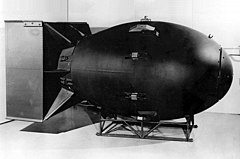Fat Man
 | |
| Państwo | |
|---|---|
| Typ | swobodnie opadająca |
| Przeznaczenie | |
| Historia | |
| Data konstrukcji | |
| Dane techniczne | |
| Długość | 3,3 m |
| Średnica | 1,5 m |
| Masa | 4670 kg |
| Równoważnik trotylowy | 21 kt |
| Dane operacyjne. Użytkownicy | |
| Stany Zjednoczone | |
Fat Man – plutonowa bomba atomowa, która w dniu 9 sierpnia 1945 została zdetonowana nad japońskim miastem Nagasaki. Jest to druga z dwóch broni jądrowych użytych podczas działań wojennych.
W odróżnieniu od zrzuconej trzy dni wcześniej na Hiroszimę bomby Little Boy zbudowanej ze wzbogacanego uranu, to urządzenie zawierało ładunek z plutonu[1]. Bomba miała długość ponad 3,3 m, średnicę 1,5 m i ważyła 4,67 tony[2]. Siła ładunku wynosiła ok. 21 kiloton TNT (84 TJ (teradżule)). Została zrzucona przez pilota Charlesa Sweeneya[3] z bombowca B-29 nazwanego przez załogę „Bockscar”.
Szacuje się, że w eksplozji w Nagasaki zginęło ponad 40 tysięcy ludzi. Tysiące osób zmarło później z powodu wybuchu bomby i oparzeń oraz setki innych z powodu choroby popromiennej[4].

1. Bezpiecznik detonujący AN 219
2. Antena radaru Archie
3. Panel z bateriami (do detonacji ładunków wybuchowych)
4. Jednostka X – układ sterujący detonacją
5. Łącznik mocujący dwie elipsoidalne połówki bomby
6. Pięciokątne fragmenty materiału wybuchowego
7. Bloki materiału wybuchowego ułożone na wzór dwudziestościanu ściętego
8. Ogon bomby (model California Parachute)
9. Powłoka głowicy (1,4 metra średnicy wewnętrznej)
10. Stożki obudowujące całość głowicy
11. Materiał wybuchowy
12. Materiał rozszczepialny
13. Panel z przyrządami sterującymi (radar, czasomierz, itp.)
14. Panel czujników barometrycznych
Zobacz też
Przypisy
- ↑ John Malik: The yields of the Hiroshima and Nagasaki nuclear explosions (ang.). Los Alamos National Laboratory. s. 16. [dostęp 2014-04-27].
- ↑ Chuck Hunsen: Volume V: US Nuclear Weapons Histories. Sunnyvale: Chukelea Publications, 1995, s. 145, seria: Swords of Armageddon: US Nuclear Weapons Development since 1945. ISBN 978-0-9791915-0-3.
- ↑ Richard Campbell: The Silverplate Bombers: A History and Registry of the Enola Gay and Other B-29s Configured to Carry Atomic Bombs. Jefferson: McFarland & Company, 2005, s. 32. ISBN 0-7864-2139-8.
- ↑ Wesley Craven, James Cate: The Pacific: Matterhorn to Nagasaki. Chicago: The University of Chicago Press, 1953, s. 723–725, seria: The Army Air Forces in World War II. OCLC 256469807.
Media użyte na tej stronie
US Flag with 48 stars. In use for 47 years from July 4, 1912, to July 3, 1959.
Budowa bomby Fatman
1. AN 219 destruct fuse 2. Archie radar antenna 3. Plate with batteries (to detonate charge surrounding nuclear components) 4. X-Unit, a firing set placed near the charge 5. Hinge fixing the two ellipsoidal parts of the bomb 6. High explosive pentagonal lens (12 units around the core, made of high and low velocity explosive) 7. High explosive hexagonal lens (20 units around the core, made of high and low velocity explosive) 8. California Parachute tail (aluminium) 9. Dural casing, ~140 cm inner diameter 10. Cones that contained the whole sphere 11. Explosive lenses (low and high velocity) 12. Nuclear material (see other figure for details about the different layers) 13. Plate with instruments (radars, baroswitches and timers)14. Barotube collector


